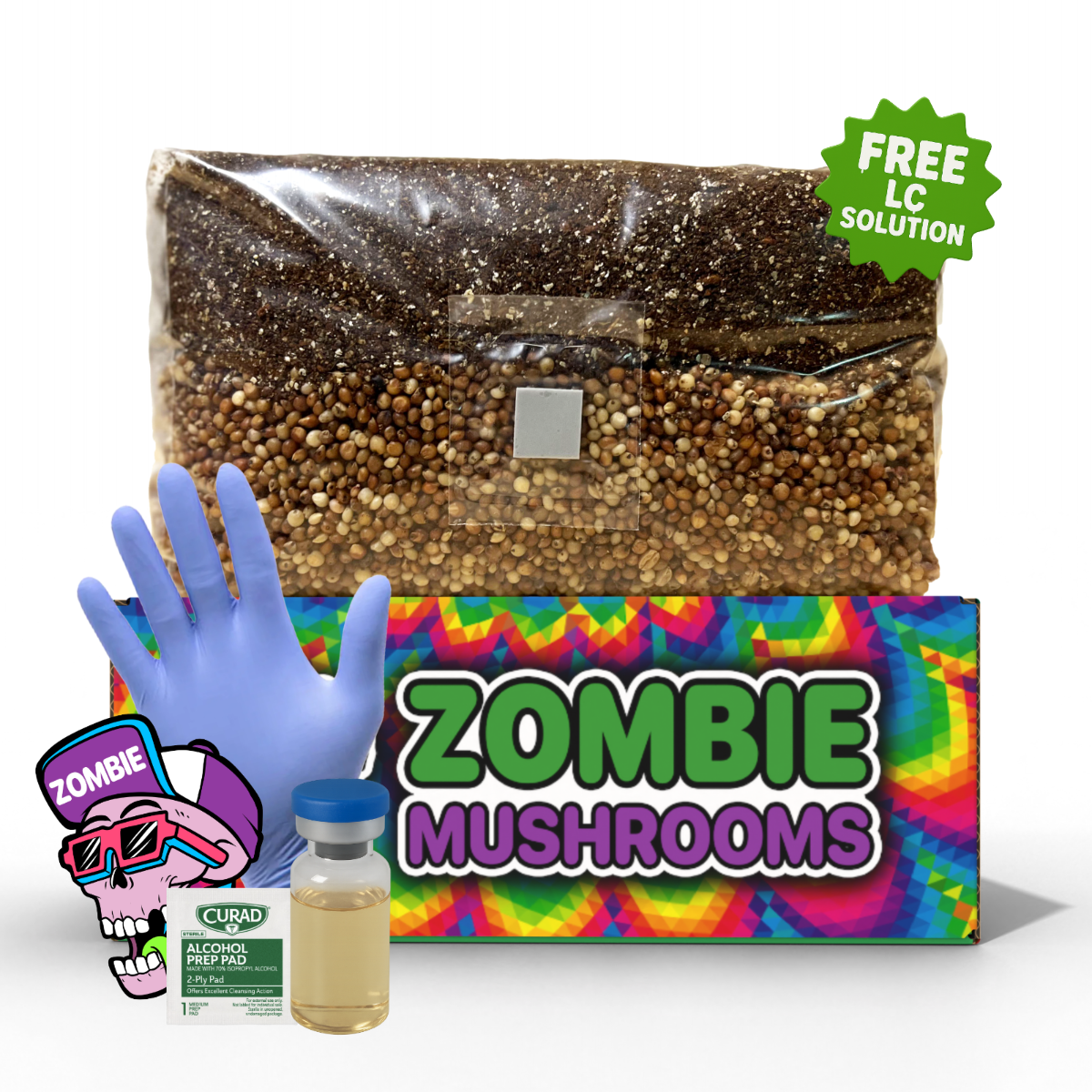⬇️ Prefer to listen instead? ⬇️
- A 2016 study showed brown rice with mycelium increased immune macrophage activity by over 25%.
- Mycelium has special bioactive compounds not in mushroom fruiting bodies.
- Mushroom mycelium fermentation makes grain more nutritious and antioxidant-rich.
- Mushroom supplement labels often hide grain filler that isn't colonized.
- Grain fully colonized by mycelium is a bioactive, therapeutic compound—not just filler.
Mushroom supplements that help boost immunity, brain function, and stress resistance are becoming popular. But when you look at the ingredients, you'll often see "myceliated grain," and it's a topic of debate. Is it just cheap filler to make capsules bigger, or is it a real food made through bioactive fermentation? This guide will tell you the truth about mushroom mycelium, explain what myceliated grain is, and if it should be part of your wellness plan. With our ready-to-use grow bags, you can cultivate real mushrooms at home—free from fillers—so you get the freshest, most authentic results for your health and wellness journey.
What is Myceliated Grain?
Mycelium is the part of the fungus that's underground or in the substrate. Think of it as the mushroom's roots. The fruiting body is the part we see as a mushroom, but the mycelium is like the organism's information network. It takes in nutrients, releases enzymes, and interacts with its surroundings.
To make myceliated grain, you put mushroom spores or mycelial culture into sterilized grain like brown rice, oats, sorghum, or millet. Over days or weeks, the mycelium grows and surrounds, gets into, and digests the grain. This isn't just on the surface. The mushroom mycelium changes the grain's chemistry. It breaks down starches and releases new enzymes, peptides, and secondary metabolites.
This makes a mix of fungal mycelium and partly digested grain. It’s a functional ingredient called “myceliated grain.” If grown in good conditions, this mix can be freeze-dried and ground into a powder with therapeutic bioactives.

Understanding Filler vs Functional
Why is myceliated grain debated in the wellness and supplement world?
The debate comes from inconsistent ways of making mushroom supplements. Some companies put grain that isn't colonized or substrates that aren't grown enough into their products. They use grain as cheap filler. Grain is much cheaper to produce than mushroom fruiting bodies or mycelium. So, some companies lower quality to make more profit.
When people say myceliated grain is “filler,” they often mean these low-quality products. These have lots of rice or oats that isn't colonized and don't give many health benefits. The problem isn't the grain itself, but if it's been fully colonized and changed by the mushroom mycelium.
Real functional myceliated grain comes from proper fermentation. The grain is changed, becomes full of fungal enzymes and compounds, and gives a mix of nutrients. This isn't new. Fermented foods like yogurt, miso, tempeh, and sourdough are similar. The starting food becomes bioactive through microbes or fungal metabolism.

Mycelium ≠ Mushroom: Key Biological Differences
Mycelium and mushroom fruiting bodies are biologically and chemically different structures. But both are useful.
- Mycelium takes in nutrients, helps the fungus survive, and interacts with its environment. It often has special compounds not in the fruiting body. These include some polysaccharides, enzymes, and myco-nutrients made when it digests substrate.
- Fruiting body is the mushroom's reproductive part. It tends to have more beta-D-glucans, triterpenes, and phenolic compounds. These are linked to immunity and antioxidant action.
Depending on the species and how it's grown, mycelium can also make immunomodulatory polysaccharides, especially α- and β-glucans, plus sterols, proteins, and other active components. For example, ergothioneine—an antioxidant known for helping protect cells—is in both mycelium and fruiting bodies. The amounts vary depending on the species and substrate.
So, when grown and processed right, mushroom mycelium is a strong bioactive component. It’s different from, but works with, the fruiting body.

Health Benefits of Fermented Myceliated Grain
The fermentation to fully colonize grain doesn't just keep the grain's compounds. It makes them better.
Research shows that mushroom mycelium colonization does these things
- Nutrients are easier to use: Enzymes break things down during fermentation. This releases amino acids, short peptides, and antioxidant compounds.
- New bioactive compounds: The mushroom's digestion makes new immune-stimulating and anti-inflammatory molecules.
- Better gut health: The result often has prebiotic fibers and immune-supporting β-glucans.
One good example is a 2016 study in the Journal of Nutrition & Functional Foods. Researchers Vetvicka, Fuller, and Richter studied fermented brown rice colonized by mushroom mycelium. They found this myceliated grain was much better than non-fermented rice at stimulating macrophage activity. Macrophage activity is an immune response marker tested in lab dishes. Specifically, immune activity increased by over 25%. This shows myceliated substrates might help modulate immunity.
This means a good mycelium supplement isn’t just doing nothing. It could actively help your body's defenses and help you be well.
Highlighting Research and Industry Data
Science supports the benefits of using both mycelium and fruiting body. A study by Chang and Wasser (2011) in the International Journal of Medicinal Mushrooms describes a model of human health that includes both submerged (mycelial) and surface-grown (fruiting body) fungi. They found that both forms give important health-support compounds. Both should be valued for their special biochemical traits.
They argue for a “pyramid model of wellness.” Using multiple fungal parts widens the therapeutic possibilities. Supplements with myceliated grain are part of this wider set of whole-system solutions. They give a multi-compound mix, not just one isolated ingredient.
Challenges With Industry Transparency
The real issue is lack of openness.
Supplement labels often don't say if products come from fruiting body, mycelium, or both. Even worse, many don't say if the grain is colonized or just added as filler. Cutting corners in manufacturing and not testing bioactivity properly means people might get a product that’s 70%-90% unfermented rice starch.
Also, there's the problem of starch numbers being misleading. Many supplement makers list “total polysaccharides” on the label. This number includes both medicinal beta-glucans and cheap, non-functional starches. Unless beta-glucans are listed specifically, you might be getting filler instead of function.

Why Testing Matters: What's Actually in Your Supplement?
Third-party testing is the answer to this unclear situation.
A good mushroom supplement company will give lab results for each batch. These results will show amounts of active compounds like beta-glucans and triterpenoids, not just total polysaccharides. These numbers better show how effective it is than just weight.
Zombie Mushrooms sets this standard by doing careful lab checks on every batch to make sure
- Beta-glucan content is correct
- No unlisted uncolonized grain
- Fungal material grown in clean, controlled conditions
This level of checking makes sure supplements give real, measurable potency, not just ingredients.

Zombie Mushrooms’ Approach: We Grow Our Own
At Zombie Mushrooms, we start from scratch.
All our mycelium supplements start with carefully chosen organic grains. These are inoculated with strong mushroom strains. We control the whole growth process to make sure full colonization happens before harvest. Our lab confirms that no uncolonized grain is left. It's just a pure, functional myceliated matrix.
Here’s what makes Zombie Mushrooms different
- Substrates are fully colonized and fermented
- No bulking agents added after harvest
- In-house growing with strict quality controls
- Clear Certificates of Analysis (COAs) for each batch
Our products are grown for a reason, not to save time.

Mycelium as a Whole-Substrate Nutraceutical
When we see myceliated grain as a whole-substrate nutraceutical, we recognize the combined power of grain and fungus working together.
Like how fermented soy becomes tempeh or miso—with a different nutrient profile than raw soy—myceliated grain gives a changed functional food. It’s rich in
- Functional fiber
- Beta-glucans
- Myco-synthesized compounds
- Amino acids
- Polyphenols made better by fermentation
This combination of metabolic activity and substrate change makes it easier to digest and absorb fungal bioactives.

Beyond the Buzzwords: How to Choose a Quality Mycelium Supplement
If you’re buying a mushroom or mycelium supplement, here’s what to check
- Look for openness: Does the label say if it has fruiting body, mycelium, or both?
- Ask for testing: Does the brand give third-party test results for beta-glucan levels?
- Avoid unclear terms: “Mushroom blend” without details could mean weak or underdeveloped biomass.
- Choose full colonization: Products where the substrate is fully fermented and changed—not just mixed after processing.
Simply put: ask for clarity, proof, and honest ingredients.
Common Myths Debunked
Let's clear up some common wrong ideas
- “Myceliated grain is just filler” – Not true if fully changed by colonization and fermentation.
- “Only fruiting bodies have antioxidants and beta-glucans” – Both structures give different but important compounds.
- “Grain makes the supplement less effective” – Only true if the grain isn’t fungalized.
Knowing how it's made helps you tell real supplements from fakes.

Functional Foods, Not Cheap Fillers
Fermented foods are strong because of the changes they go through. Kombucha changes tea and sugar. Kimchi changes cabbage and salt. Myceliated grain changes oats or rice into a complex, enzyme-rich, immune-supporting biomass.
Instead of seeing grain as a bad thing, we should see it as a base. Mycelium uses it to make a new wellness food. Made correctly, it’s not cheap filler. It’s a combined structure with lots of potential to support health.
The Future of Mushroom Supplements: Transparency, Research, and Results
As people learn more, the need for clarity, strength, and honest sourcing will shape the future of mushroom supplements. Brands that put money into science, quality testing, and clear labels will gain customer trust in a crowded market.
At Zombie Mushrooms, we're working to push these standards forward. Myceliated grain is not something we hide. It’s something we're proud of. Through controlled fermentation, lab checks, and clear communication, we're making mycelium supplements what they should be in the health world.
Ready to try a mushroom supplement with nothing to hide? See Zombie Mushrooms’ fully colonized products and feel the difference real openness makes.
References
- Chang, R.Y., & Wasser, S.P. (2011). The role of culinary-medicinal mushrooms on human welfare with a pyramid model for human health. International Journal of Medicinal Mushrooms, 13(2), 95–134. https://doi.org/10.1615/IntJMedMushr.v13.i2.10



